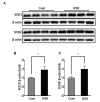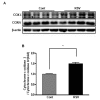Resveratrol, an Nrf2 activator, ameliorates aging-related progressive renal injury
- PMID: 29326403
- PMCID: PMC5811244
- DOI: 10.18632/aging.101361
Resveratrol, an Nrf2 activator, ameliorates aging-related progressive renal injury
Abstract
Background: Two important issues in the aging kidney are mitochondrial dysfunction and oxidative stress. An Nrf2 activator, resveratrol, is known to have various effects. Resveratrol may prevent inflammation and oxidative stress by activating Nrf2 and SIRT1 signaling. We examined whether resveratrol could potentially ameliorate the cellular condition, such as renal injury due to cellular oxidative stress and mitochondrial dysfunction caused by aging.
Methods: Male 18-month-old C57BL/6 mice were used. Resveratrol (40 mg/kg) was administered to aged mice for 6 months. We compared histological changes, oxidative stress, and aging-related protein expression in the kidney between the resveratrol-treated group (RSV) and the control group (cont). We performed experiments using small-interfering RNAs (siRNAs) for Nrf2 and SIRT1 in cultured HK2 cells.
Results: Resveratrol improved renal function, proteinuria, histological changes and inflammation in aging mice. Also, expression of Nrf2-HO-1-NOQ-1 signaling and SIRT1-AMPK-PGC-1α signaling was increased in the RSV group. Transfection with Nrf2 and SIRT1 siRNA prevented resveratrol-induced anti-oxidative effect in HK2 cells in media treated with H2O2.
Conclusions: Activation of the Nrf2 and SIRT1 signaling pathways ameliorated oxidative stress and mitochondrial dysfunction. Pharmacological targeting of Nrf2 signaling molecules may reduce the pathologic changes of aging in the kidney.
Keywords: SIRT1-Nrf2; aging; kidney; oxidative stress; resveratrol.
Conflict of interest statement
Figures











References
-
- Baylis C, Corman B. The aging kidney: insights from experimental studies. J Am Soc Nephrol. 1998; 9:699–709. - PubMed
Publication types
MeSH terms
Substances
LinkOut - more resources
Full Text Sources
Other Literature Sources

